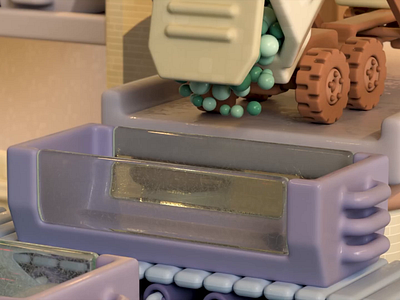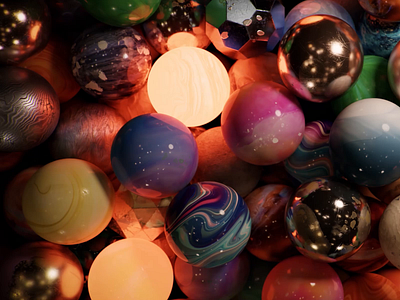It’s no secret that the 3D design and illustration industry is huge. Between modeling, digital sculpting, animation, and more, learning 3D can be pretty overwhelming.
Before you leap into the world of 3D design with both feet, you should have an idea of what you want to do, as different paths require different steps. Having 3D skills can open up new career possibilities for people with graphic design, product design, illustration, or another creative background.
This article will teach you how to break into this rapidly growing field of design, what tools and programs you need, and how to get hired for 3D design and illustration jobs. Let’s get straight into it!
✏️ Thanks to our friends at NVIDIA for sponsoring this blog post!
1. Determine your area of focus
The fact that you’re reading this probably means you already have an idea of what you want to accomplish through 3D design and illustration. But if you are simply looking to expand your abilities and grow as a designer, there are some different options for learning 3D.
There are many different career paths and, subsequently, opportunities for 3D design that all require slightly different skills and training. For example:
- 3D Illustration — For magazines, product design, advertising campaigns, websites, billboards, flyers, animations, or interactive content.
- Game design — 3D in games requires real-world detail, with characters modeled on specific people and their movements or cool visual effects.
- Movies & TV — Ever dreamed of working at Pixar or on other CG integrated movies like the Avengers? 3D has numerous applications in movies and television.
- VR/AR — by adding layers of information on top of the physical environment, 3D adds new dimensionality to the real world… or an entirely new world altogether.
As you can see, 3D design and illustration can be applied to various career paths. Once you identify your area of focus, you can tailor your portfolio to projects that will help you get hired in the field you want.
2. Find the right tool for your 3D needs
When it comes to 3D tools, finding the right technology to meet your needs can be a challenge. That’s why NVIDIA Omniverse was created with 3D designers and illustrators in mind.
This practical platform for design collaboration empowers new creators with step-by-step tutorials from industry experts. NVIDIA Omniverse also enables you to enhance and speed up your creative apps and workflows for established creators, allowing you to create faster and better 3D projects. The live-sync creation is a gamechanger, and it integrates seamlessly with all your favorite design apps.
The Omniverse is a practical platform to start creating and is paving the way for how creators will design 3D content in the future. In this video, a community member shows off some of the best features of Omniverse for Creators.
3. Learn the fundamentals of 3D design
3D modeling, as we know, can be pretty complicated. Fundamentally, you’ll need to understand 3D modeling terms, 3D environments, types of modeling, and how they all work together to create a final product.
You can learn 3D fundamentals in many different ways. Some designers are self-taught, while others have taken boot camps, ad hoc courses, or even earned degrees in 3D modeling for games and movies (though this is relatively new and by no means a requirement to excel).
There’s always YouTube, where you can sift through videos to find whatever you’re looking for. You can also find great in-depth 3D tutorials on NVIDIA’s YouTube channel, which expert creators around the world produce. There are tutorials for all skill levels and tool preferences, so you can follow along no matter which program you’re learning.
4. Build a body of work
Create a portfolio of work that reflects the types of 3D projects you would like to be hired for. Of course, self-initiated projects are one of the best ways to build your skills and develop your style. 3D modeling is no exception to this adage: practice makes perfect.
After you’ve compiled a portfolio of projects you’re proud of (and that demonstrates your current skill level), you should begin to market yourself as a 3D specialist. You should include the tools you are proficient in as well.
Whenever you are ready, you can upload your shots to Dribbble, share your portfolio work on social media, and start applying for 3D gigs!
5. Connect & collaborate with other 3D designers
Although you may not realize it yet, a fantastic community of designers pursuing careers and projects in the 3D space. Staying connected to this community and collaborating with your fellow 3D designers will allow you to keep on top of emerging technologies and trends, help you learn, and provide you with all sorts of feedback on your work and career advice.
The NVIDIA Omniverse is a great place to receive this type of support while meeting new friends and colleagues in 3D. You can see just how talented this community of artists is by checking out 3D renderings and simulations with the #MadeInOmniverse hashtag.
Start your 3D journey today
You need the right tools and resources at your disposal to become a 3D designer. Finding your ideal area of focus, learning the basics of 3D design, and developing a killer portfolio are significant steps to getting started, but connecting with other 3D enthusiasts and choosing the right tools is equally important.
You can create like never before with NVIDIA Omniverse’s collaboration platform, which enhances and speeds up your creative workflows. Check out NVIDIA Studio Laptops & Desktops for the right 3D hardware. We can’t wait to see what you create! ■
![]() About the Author: Olivia Hoskin is a freelance writer with a background in tech and marketing. A true design fan at heart, you’ll find her writing about the latest industry trends, technologies, and the inspiring endeavors of fellow creators. She’s a champion of remote work, a lover of responsible technology, and a fitness geek and enjoyer of the outdoors in her spare time. Find her at oliviahoskin.com.
About the Author: Olivia Hoskin is a freelance writer with a background in tech and marketing. A true design fan at heart, you’ll find her writing about the latest industry trends, technologies, and the inspiring endeavors of fellow creators. She’s a champion of remote work, a lover of responsible technology, and a fitness geek and enjoyer of the outdoors in her spare time. Find her at oliviahoskin.com.
Find more Community stories on our blog Courtside. Have a suggestion? Contact stories@dribbble.com.











